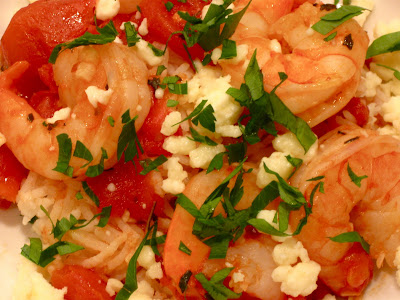
A comment left by Indochine Kitchen on "Identity Bites, Part II" made me think about how a society's food and foodways serve not only to reinforce identity and existing group bonds but also help to project that identity to others and help create new bonds with outside groups.
I can count on one hand the number of countries to which I have traveled in my lifetime and that includes both my birthplace and current home. For those of us who enjoy the cuisines of places we have yet to visit, food allows us to travel on a dinner plate and opens a gateway to learning about those new cultures. Whether consumed at a restaurant or prepared at home, national cuisines can tell us so much about another society from a distance. For example, the absence of some ingredients such as certain meats may reflect dietary restrictions of a dominant religion while the abundance of other ingredients such as seafood and cheese may point out a country's geographic locale or its natural resources. We may even learn about social attitudes from the way others eat: in some cultures, women and men take their meals separately and in others, interfamily hierarchy determines who is served first at the table.
Because food is the focus of my studies, I have a tendency to overthink my eating habits and food preferences and must remind myself that eating ethnic cuisine is sometimes simply about consuming delicious food. Still, the next time you sit down to enjoy a dish from a culture different from your own, savor a bite then ask yourself if your food is trying to telling you something.
Shrimp and Feta in a Tomato Basil Sauce

I first had Greek food at an Orthodox Greek Church festival in Raleigh, NC where, not surprisingly, I zeroed in on desserts like baklava, galaktoboureko, and loukomades. When I managed to wean myself from the sweet stuff, I knew that the rest of the cuisine had to be equally addictive. This dish features two of my favorite and quintessentially Greek ingredients. Once again, the recipe is my own only in the sense that I threw it together without following someone else's directions. After some Google research, I believe this is similar to garides saganaki, a baked shrimp and feta dish. To learn more about the signature ingredients of Greek cuisine, check out the blog History of Greek Food.
Serves 2-4
Recommended rice: Basmati
1 lb raw shrimp, peeled and deveined
2 cups fresh tomatoes, diced or 1 (14.5 oz) can diced tomatoes
2-3 cloves garlic, minced
2 Tbs olive oil
1-2 tsps dried oregano
1-2 tsps dried basil or 1/4 cup fresh basil, chiffonade
1/2 cup dry white wine such as Pinot Grigio
1/4 - 1/2 tsp crushed red pepper
Salt to taste
Feta cheese, crumbled
1. Heat olive oil in a large skillet or sauté pan over medium-high heat.
2. Add garlic and saute until fragrant, being careful not to brown.
3. Add fresh or canned tomatoes and dried herbs (if using fresh basil, wait until just before serving). Bring to a gentle simmer.
4. Add white wine and continue to simmer on med-low heat, covered, until tomatoes are broken down.
5. Add shrimp and crushed red pepper. Allow to simmer gently until shrimp is opaque and cooked through, about 8-10 minutes. Add basil if using fresh and salt to taste.
6. Turn off heat and spoon over freshly steamed Basmati rice. Sprinkle with Feta cheese, allowing residual heat to melt/soften it then serve.









6 comments:
truly! A way to travel without ever leaving your kitchen!
Indeed, it’s amazing how ethnic heritage is presrved through food, how identity is reinforced and passed down to other generations and, on the other hand, how food becomes a powerful way of excanging ideas and traditions, a vehicle of adapting or absorbing the culinary cultures of others. However, I wonder how much we accept a community by just eating their food.
Your blog is very interesting... and I like your version of saganaki, the rice brings a special touch.
Joie - the best part is your destination is limited only by finding a recipe!
Mariana - Thank you for your insight! Excellent point about how much we accept a community through their food. Some foods are appropriated by a dominant culture and separated from its community origins. I think of the discordant attitudes in the US toward Latino (i.e. Mexican) cuisine and Latinos themselves. Their food has become ubiquitous and Americanized (Taco Bell, Chipotle) and yet the community itself must still fight for acceptance.
Your post got me thinking about the absence of ingredients...how unfamiliar ingredients, because they weren't consumed as a child, can take some time to be enjoyed. It also reminded me a visit to my mother's family in Korea - I was sick and missed a dinner of grilled beef. Beef was extremely hard to come by (access and money)when my mom was growing up - my aunt was so distressed I missed the beef dinner she bought me sweets from a special bakery for three days.
Gastroanthro - Thank you for sharing that memory! Your comment about unfamiliar ingredients and how it takes awhile to enjoy is something I experienced myself (and will actually be discussed in my next entry for "Identity Bites"). I so missed having any kind of Filipino food that I ate whatever I could find whenever, including a particular dish that I never thought I'd ever want to eat! Now it's my favorite.
Post a Comment